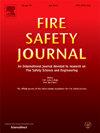Fire resistance of existing steel structures with aged intumescent coating based on an in situ test method
IF 3.4
3区 工程技术
Q2 ENGINEERING, CIVIL
引用次数: 0
Abstract
Intumescent coatings are commonly used in civil engineering to increase the fire resistance of steel structures. Exposed to fire, the intumescent coating reacts and forms a thermal protective char around the steel member. Thus, the heating of the steel is significantly slowed down and the fire resistance can be improved. Information regarding the scope of application and the durability of intumescent coatings are given in national approvals or European Technical Assessment documents. Due to the environmental conditions, intumescent coatings are subjected to ageing effects, which can reduce the durability and their thermal protection performance. To predict the durability for several years, during the approval procedure the behaviour of intumescent coatings is predominantly extrapolated based on accelerated artificial ageing. The established German and European assessment procedures to test and assess durability assume a working life of at least 10 years. Additional evidence may be required for longer periods. However, at present there is no method of verifying the thermal performance of existing structural members on site. For this reason, BAM is conducting the research project "INSIST" [1] to develop a minimally invasive in situ test method to determine the fire resistance of existing steel structures with applied intumescent coating. The investigation includes the development of a mobile prototype furnace. The paper describes the test setup, the developed prototype furnace, and the results of the performed test programme on uncoated and coated steel specimens. Based on this, recommendations for the test procedure are given.
基于原位试验方法的老化膨胀涂层既有钢结构耐火性能研究
膨胀涂料是土木工程中常用的一种提高钢结构耐火性能的涂料。暴露在火中,膨胀涂层发生反应并在钢构件周围形成热保护炭。因此,大大减缓了钢的加热速度,提高了耐火性能。有关膨胀涂层的应用范围和耐久性的信息在国家批准或欧洲技术评估文件中给出。由于环境条件的影响,膨胀涂层会受到老化的影响,从而降低其耐久性和热防护性能。为了预测几年的耐久性,在批准过程中,膨胀涂层的行为主要是根据加速人工老化来推断的。既定的德国和欧洲评估程序测试和评估耐久性假设工作寿命至少为10年。可能需要更长时间的额外证据。然而,目前还没有办法现场验证现有结构构件的热性能。因此,BAM正在开展“坚持”[1]研究项目,开发一种微创原位测试方法,以确定应用膨胀涂层的现有钢结构的耐火性。该研究包括开发一个移动原型炉。本文介绍了试验装置、研制的原型炉以及对未涂覆和涂覆钢试样进行的试验程序的结果。在此基础上,提出了试验程序的建议。
本文章由计算机程序翻译,如有差异,请以英文原文为准。
求助全文
约1分钟内获得全文
求助全文
来源期刊

Fire Safety Journal
工程技术-材料科学:综合
CiteScore
5.70
自引率
9.70%
发文量
153
审稿时长
60 days
期刊介绍:
Fire Safety Journal is the leading publication dealing with all aspects of fire safety engineering. Its scope is purposefully wide, as it is deemed important to encourage papers from all sources within this multidisciplinary subject, thus providing a forum for its further development as a distinct engineering discipline. This is an essential step towards gaining a status equal to that enjoyed by the other engineering disciplines.
 求助内容:
求助内容: 应助结果提醒方式:
应助结果提醒方式:


